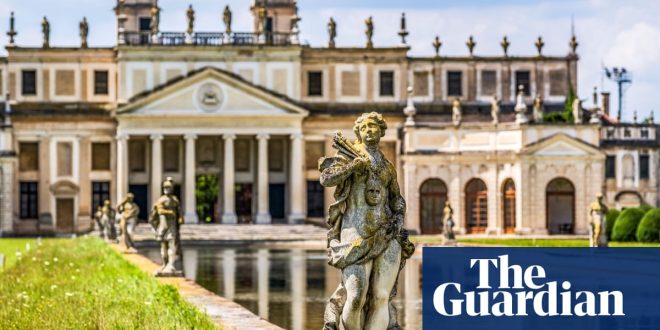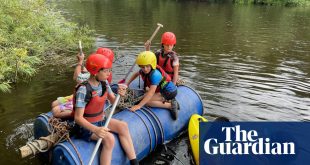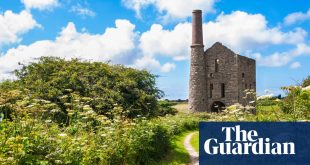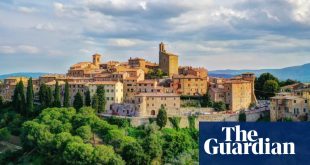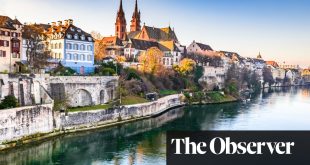First impressions heading out of Venice on the Ponte della Libertà, the bridge over La Serenissima’s lagoon to the Domini di Terraferma, are not very promising, as I pass by the giant refineries of the mainland’s petrochemical industry, then the immense skeleton of a mega cruise liner under construction in sprawling maritime dockyards. But after 20 minutes, verdant countryside suddenly replaces built-up suburbia as my bus arrives alongside the snaking banks of the Naviglio del Brenta, the final part of the mighty Brenta river that engineers made “navigable” like a canal, back in the 16th century.
Known as the Riviera del Brenta, this bucolic rural paradise was where Venice’s wealthy nobility sought to escape the heat and noisy crowds of the city by building palatial waterside boltholes. Fabulous villas emerged with gardens designed by Antonio Palladio and his proteges, decorated with stunning frescoes by the likes of Giovanni Tiepolo.
Today, the Riviera is experiencing a renaissance, becoming a slow eco-destination; more travellers are choosing to avoid Venice’s daily invasion of tourists to base themselves here, in affordable accommodation that ranges from friendly campsites to rustic agriturismos, family-run B&Bs to plush, restored villas. The whole of the riviera, running for 25 miles from Stra, just outside Padua, is linked by the trusty 53E bus, and I have booked a waterside hideaway for a lazy weekend of walking, biking and sailing.
The bus stops just outside the scenic town of Dolo, about the halfway point of the riviera, and a pleasant 25-minute walk from Dimora Naviglio (doubles from €96 B&B), a tiny 18th-century labourer’s cottage right on the water. It is the home of Gianluca Maggiori, who created three guest rooms in 2017. Venetian Gianluca is on a mission to convince tourists to discover a new world of attractions on the Riviera del Brenta. He runs his own travel and bike hire company, while B&B guests get a bike to use during their stay.
Gianluca tells me: “The guests who left this morning are typical of the new kind of travellers we are seeing here. They did not want all the bother of visiting Venice, the crowds and now the entry tickets. They came here to discover our countryside, an unspoilt environment, the cultural history of the riverside villas, and the traditional Veneto cuisine and wines served in our village osterie.”
Gianluca is a mine of information and tips, even for an initial stroll into Dolo. At the end of the road is the little-known 16th-century Villa Badoer Fattoretto, whose owner has created a fascinating museum illustrating daily agricultural life here; behind the facades of the sumptuous villas were working farms and vineyards whose produce would be transported by barge to Venice. There is still a farmer’s cooperative next door, the Cantina Riviera del Brenta, where it is impossible to resist stocking up with artisan sausages, honey and cheeses, plus a litre of the local vino straight from the tap.
The ancient port of Dolo stretches across both sides of the Brenta, a maze of locks and bridges, a traditional boatyard and a beautifully preserved mill that is unchanged since Canaletto immortalised the landscape around 1730. The mill is now a chic enoteca and while not the cheapest spot in town for a glass of prosecco, it has unbeatable sunset views.
Gianluca recommends the waterside Osteria da Caronte for dinner, where dishes such as spaghetti smothered with lagoon clams (€12), and tender cuttlefish simmered in its own black ink (€15) have been served for more than a century.
after newsletter promotion
From the B&B, a gentle five-mile riverbank bike ride leads to Stra, whose stately Villa Pisani is very much the jewel in the crown of the Brenta Riviera. It features a breathtaking Tiepolo ceiling fresco, whose wispy clouds seem to carry you away, plus ornamental ponds, gardens and even a maze. It is spectacular, and just down the road. I was even more impressed by the Villa Foscarini Rossi, which houses the Shoe Museum of the Rossi family, one of the many old artisan businesses along the Brenta. Though owned today by the global luxury brand LMVH, which also produces Dior accessories nearby, the 1,500 shoe collection showcases Lacroix, YSL, Pucci and Fendi. At the back of the villa, I explore a grand old farm building, the villa’s barchessa, once used for storing grain and wine barrels, but still decorated with frescoes, whose soaring entrance hall is popular today for weddings and christenings.
Wherever I stop off along the Brenta there is activity on the water: locals standing up, Venetian-style, to row their gondola-like boats, younger enthusiasts on paddleboards, kayaks, canoes, and private boats quietly chugging by. At Stra, I share a plate of tasty cicchetti (Venetian tapas) in the sporty Cicloosteria with Giacomo Bozzolan, who takes tourists out on his PinnaGialla eco-kayak tour. “I did not want to just rent our kayaks and let people explore on their own,” he says. “So our 90-minute tour is led by myself or one of our guides, who explains the natural habitat, history of the villas, flora and fauna, the historical agricultural activities here. All viewed from the water, which gives a unique perspective.”
After passing by the picturesque village of Mira and its exquisite Villa Widmann, I make a final stop at the Riviera’s other crown jewel, Villa Foscari, known as La Malcontenta. This is a far more minimalist, almost majestic masterpiece built by Palladio as a summer hideaway for the Foscari family. And the stars of the show are hidden away inside, a series of stunning 16th-century frescoes alongside a striking contemporary sculpture created 450 years later by architect Zaha Hadid.
From Malcontenta, a 10-minute bus ride through the wetlands returns me to the lagoon, where vaporetto number 16 from Fusina crosses the water all the way to Venice. Not quite the style of the regal burchiello boats that ferried Venetian nobility back and forth to the riviera, but still a slow, peaceful return to the hustle and bustle of La Serenissima.
 Top Naija News – Nigeria News, Nigerian News & Top Stories Top Naija News – Nigerian Newspapers, Nigerian News. topnaijanews is a daily Nigerian newspaper covering Latest News, Breaking News, Entertainment, Sports, Lifestyle and Politics.
Top Naija News – Nigeria News, Nigerian News & Top Stories Top Naija News – Nigerian Newspapers, Nigerian News. topnaijanews is a daily Nigerian newspaper covering Latest News, Breaking News, Entertainment, Sports, Lifestyle and Politics.
